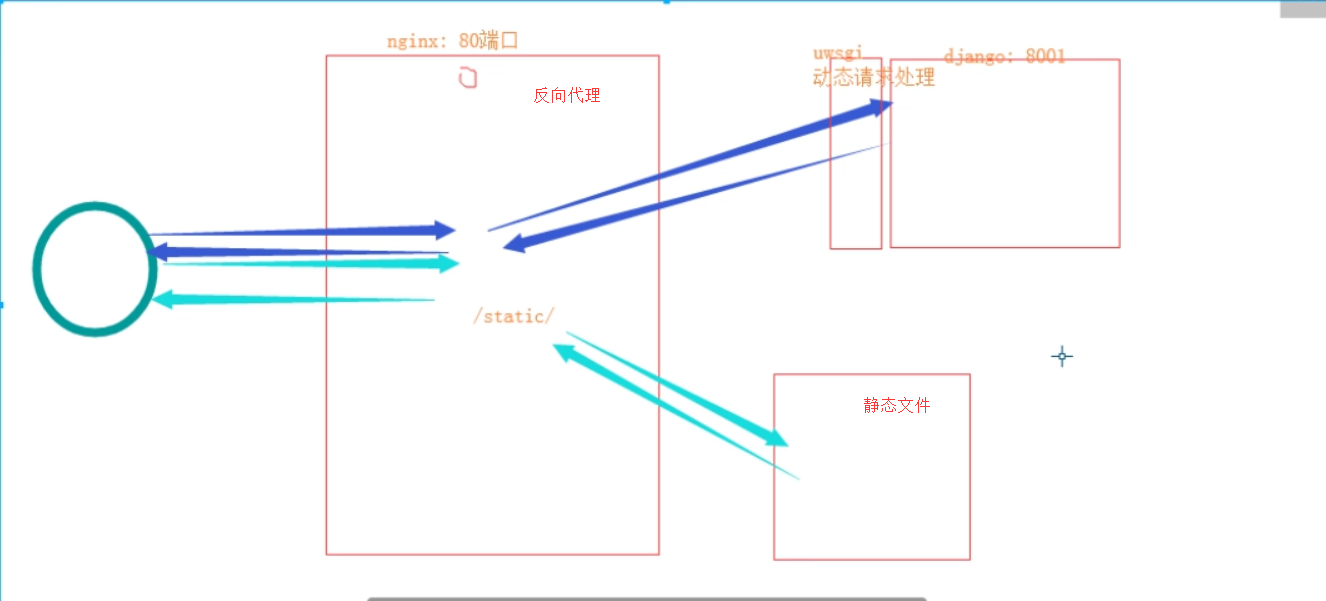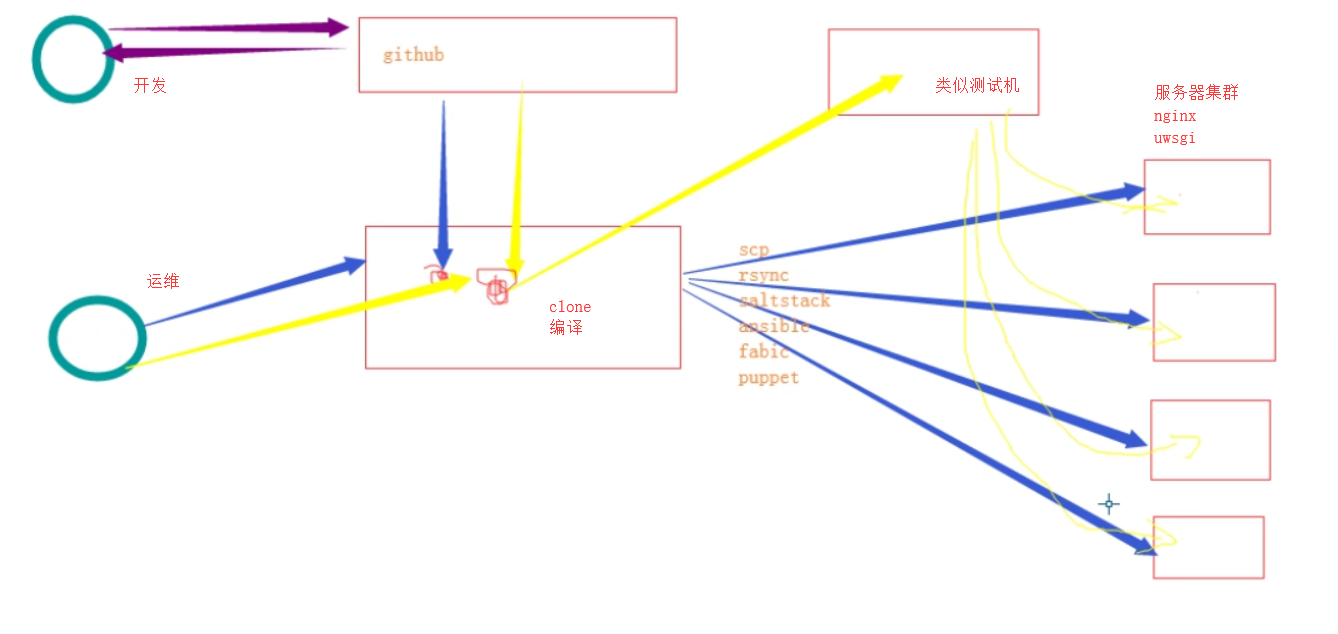Django项目部署
一、打包文件传到服务器
参考博客:https://www.cnblogs.com/wupeiqi/articles/8591782.html
http://www.cnblogs.com/alex3714/p/6538374.html
二、服务器环境准备好
安装Python3:
(http://www.cnblogs.com/wupeiqi/articles/4906230.html)
http://www.cnblogs.com/alice-bj/articles/9277961.html
1、安装gcc,用于编译Python源码
yum install gcc
2、下载源码包,https://www.python.org/ftp/python/
3、解压并进入源码文件
4、编译安装
./configure
make all
make install
模式:/usr/local/bin/python3
安装django:
pip3 install django==1.11.7
报错:no module _sqlite3
所以应该先装:yum install sqlite-devel
重新编译安装py3
./configure
make
make install
三、运行
- 1.解压
- 2.配置:ALLOWED_HOSTS = ['*',] # 允许访问
- 3.配置:DEBUG = False
# 用户看不到错误信息,以及暴露出来的url;注意改完之后,样式没有了!!
# 为什么?因为django对静态文件上线时,需要特殊处理。
- 4.找到django程序中每一个app和全局的静态文件,统一放置到某处。
# python3 manage.py
# python3 manage.py collectstatic
# 报错:You're using the staticfiles app without having set the STATIC_ROOT setting to a filesystem path.
# 静态文件收集到哪里?STATIC_ROOT
# 需要在 settings中配置 STATIC_ROOT = "allstatic"
# 之后在 python3 manage.py collectstatic 这样所有的静态文件就都收集到了项目下的allstatic下面
# 因为django对静态文件处理特别次,所以选择用nginx专门处理静态文件。

- 5.python manage.py runserver 0.0.0.0:8001
四、Nginx做反向代理(处理静态文件)
安装:
yum install nginx
# cat /etc/nginx/nginx.conf
配置文件:
user root; worker_processes 4; #核数 error_log /var/log/nginx/error.log; pid /var/run/nginx.pid; events { worker_connections 1024; # IO多路复用,监听socket发生变化的,监听最多的连接数 } http { log_format main '$remote_addr - $remote_user [$time_local] "$request" ' '$status $body_bytes_sent "$http_referer" ' '"$http_user_agent" "$http_x_forwarded_for"'; access_log /var/log/nginx/access.log main; sendfile on; tcp_nopush on; tcp_nodelay on; keepalive_timeout 65; include /etc/nginx/mime.types; default_type application/octet-stream; upstream django { server 127.0.0.1:8001; } server { listen 80; charset utf-8; # max upload size client_max_body_size 75M; location /static { alias /data/s9deploy/allstatic; } location / { uwsgi_pass django; include uwsgi_params; } } }
运行起来:systemctl start nginx # 默认是80端口
service nginx start # Centos6.9用这个实现了
五、uwsgi替换原来的wsgiref
安装:
pip3 install uwsgi
使用:
uwsgi启动django : uwsgi --socket 127.0.0.1:8001 --chdir /data/s9deploy/ --wsgi-file s9deploy/wsgi.py
uwsgi --socket :8002 --chdir /data/deploy/ --wsgi-file deploy/wsgi.py
六、操作
1. 程序
DEBUG = False
ALLOWED_HOSTS = ['*',]
STATIC_ROOT = "allstatic"
2. 程序:s9deploy.zip 上传到服务器
yum install lrzsz
3. 解压:
yum install unzip
4. 安装uwsgi
pip3 install uwsgi
代替wsgi运行django:
不处理静态文件:
uwsgi --http 0.0.0.0:8001 --chdir /data/s9deploy/ --wsgi-file s9deploy/wsgi.py
处理静态文件:
python manage.py collectstatic # /data/s9deploy/allstatic
uwsgi --http 0.0.0.0:8001 --chdir /data/s9deploy/ --wsgi-file s9deploy/wsgi.py --static-map /static=/data/s9deploy/allstatic
简单运行方式:
vim uwsgi_s9deploy.ini
[uwsgi]
http = 0.0.0.0:8001 # scoket = 0.0.0.0:8001
chdir = /data/s9deploy/
wsgi-file = s9deploy/wsgi.py
processes = 4
static-map = /static=/data/s9deploy/allstatic
uwsgi --ini /data/s9deploy/uwsgi_s9deploy.ini
5. 安装nginx
yum install nginx
配置:
user root; worker_processes 4; error_log /var/log/nginx/error.log; pid /var/run/nginx.pid; events { worker_connections 1024; } http { log_format main '$remote_addr - $remote_user [$time_local] "$request" ' '$status $body_bytes_sent "$http_referer" ' '"$http_user_agent" "$http_x_forwarded_for"'; access_log /var/log/nginx/access.log main; sendfile on; tcp_nopush on; tcp_nodelay on; keepalive_timeout 65; include /etc/nginx/mime.types; default_type application/octet-stream; upstream django { server 127.0.0.1:8001; server 127.0.0.1:8002; } server { listen 80; charset utf-8; # max upload size client_max_body_size 75M; location /static { alias /data/s9deploy/allstatic; } location / { uwsgi_pass django; include uwsgi_params; } } }
6. 安装supervisor,检测进程不要被关闭。
第二阶段:管理工具,ansible/fabric/puppet/saltstack
第三阶段:基于git + 管理工具
第四阶段:jekins web程序
七、总结
nginx 做了负载均衡, web集群,多个机器处理请求
uwsgi_deploy_8002.ini uwsgi_deploy_8003.ini
uwsgi --ini /data/s9deploy/uwsgi_s9deploy_8001.ini & # 后台运行
uwsgi --ini /data/s9deploy/uwsgi_s9deploy_8002.ini &
nginx 反向代理;请求制作转发 静态文件自己处理 动态文件 交给uwsgi
192.168.12.22:8001
192.168.12.23:8001
192.168.12.22: uwsgi:配置文件 + 代码
192.168.12.23: uwsgi: 配置文件 + 代码
运行: uwsgi --ini /data/s9deploy/uwsgi_s9deploy_8002.ini &
uwsgi 也可以 开进程; processes = 4
nginx接4个,后台接 4个 ,实现并发 (加一个& 后台运行 不卡住;)
uwsgi --ini uwsgi_deploy_8002.ini &
----------------------------
第二阶段: 批量上传 批量
----------------------------
项目部署方案:
supervisor 监测这三个进程 看谁的进程死掉了,会自动启动; 安装supervisor,检测进程不要被关闭。
如果关闭,立即重启;
ps -ef|grep uwsgi
kill -9 3101
假设:程序要做负载均衡;
两个uwsgi 一个nginx 有三个程序运行;
----------------------
八、code 配置


user root; worker_processes 4; error_log /var/log/nginx/error.log; pid /var/run/nginx.pid; events { worker_connections 1024; } http { log_format main '$remote_addr - $remote_user [$time_local] "$request" ' '$status $body_bytes_sent "$http_referer" ' '"$http_user_agent" "$http_x_forwarded_for"'; access_log /var/log/nginx/access.log main; sendfile on; tcp_nopush on; tcp_nodelay on; keepalive_timeout 65; include /etc/nginx/mime.types; default_type application/octet-stream; upstream django { server 127.0.0.1:8003; server 127.0.0.1:8004; # server 192.1.123.1; } server { listen 80; charset utf-8; # max upload size client_max_body_size 75M; location /static { alias /data/deploy/allstatic; } location / { uwsgi_pass django; include uwsgi_params; } } }

""" Django settings for deploy project. Generated by 'django-admin startproject' using Django 1.11.11. For more information on this file, see https://docs.djangoproject.com/en/1.11/topics/settings/ For the full list of settings and their values, see https://docs.djangoproject.com/en/1.11/ref/settings/ """ import os # Build paths inside the project like this: os.path.join(BASE_DIR, ...) BASE_DIR = os.path.dirname(os.path.dirname(os.path.abspath(__file__))) # Quick-start development settings - unsuitable for production # See https://docs.djangoproject.com/en/1.11/howto/deployment/checklist/ # SECURITY WARNING: keep the secret key used in production secret! SECRET_KEY = '&4r0zssdr8%(cph&+^nx#k)r+rpwpw)^_q)2f7()*a3ki8p^ju' # SECURITY WARNING: don't run with debug turned on in production! DEBUG = False ALLOWED_HOSTS = ['*',] # Application definition INSTALLED_APPS = [ 'django.contrib.admin', 'django.contrib.auth', 'django.contrib.contenttypes', 'django.contrib.sessions', 'django.contrib.messages', 'django.contrib.staticfiles', 'app01.apps.App01Config', ] MIDDLEWARE = [ 'django.middleware.security.SecurityMiddleware', 'django.contrib.sessions.middleware.SessionMiddleware', 'django.middleware.common.CommonMiddleware', 'django.middleware.csrf.CsrfViewMiddleware', 'django.contrib.auth.middleware.AuthenticationMiddleware', 'django.contrib.messages.middleware.MessageMiddleware', 'django.middleware.clickjacking.XFrameOptionsMiddleware', ] ROOT_URLCONF = 'deploy.urls' TEMPLATES = [ { 'BACKEND': 'django.template.backends.django.DjangoTemplates', 'DIRS': [os.path.join(BASE_DIR, 'templates')] , 'APP_DIRS': True, 'OPTIONS': { 'context_processors': [ 'django.template.context_processors.debug', 'django.template.context_processors.request', 'django.contrib.auth.context_processors.auth', 'django.contrib.messages.context_processors.messages', ], }, }, ] WSGI_APPLICATION = 'deploy.wsgi.application' # Database # https://docs.djangoproject.com/en/1.11/ref/settings/#databases DATABASES = { 'default': { 'ENGINE': 'django.db.backends.sqlite3', 'NAME': os.path.join(BASE_DIR, 'db.sqlite3'), } } # Password validation # https://docs.djangoproject.com/en/1.11/ref/settings/#auth-password-validators AUTH_PASSWORD_VALIDATORS = [ { 'NAME': 'django.contrib.auth.password_validation.UserAttributeSimilarityValidator', }, { 'NAME': 'django.contrib.auth.password_validation.MinimumLengthValidator', }, { 'NAME': 'django.contrib.auth.password_validation.CommonPasswordValidator', }, { 'NAME': 'django.contrib.auth.password_validation.NumericPasswordValidator', }, ] # Internationalization # https://docs.djangoproject.com/en/1.11/topics/i18n/ LANGUAGE_CODE = 'en-us' TIME_ZONE = 'UTC' USE_I18N = True USE_L10N = True USE_TZ = True # Static files (CSS, JavaScript, Images) # https://docs.djangoproject.com/en/1.11/howto/static-files/ STATIC_URL = '/static/' STATICFILES_DIRS = [ os.path.join(BASE_DIR, 'static') ] STATIC_ROOT = os.path.join(BASE_DIR, "allstatic")
九、图片



十、补充
项目开发完毕后,需要将代码放到服务器上,这样用户才能访问。接下来我们一步一步来进行一波部署操作。
1. 简单粗暴
项目开发完毕,在部署之前需要再配置文件中将 ALLOWED_HOSTS配置设置为:当前服务器IP或*,如:
|
1
|
ALLOWED_HOSTS = ["*",] |
然后将源码上传至服务器指定目录,如:/data/ ,然后执行命令来运行:
注: 上传命令: scp /Users/wupeiqi/PycharmProjects/oldboy-1.zip root@192.168.10.33:/data/
解压,进入目录并执行以下命令:
|
1
|
python3 mange.py runserver 0.0.0.0:8000 |
类似这样的上线网站:

2. uwsgi
Django框架运行依赖wsgi(本质提供socket服务端),众多模块实现了wsgi规范,而django框架中默认使用wsigiref模块来实现,他由于性能比较低,所以用于本地开发和测试,而线上部署时需要使用uwsgi来代替。
a. 在服务器上安装uwsgi
|
1
|
pip3 install uwsgi |
需要先安装:yum install python-devel
b. 单文件使用uwsgi
在服务器上编写一个Python文件:
|
1
2
3
|
def application(env, start_response): start_response('200 OK', [('Content-Type','text/html')]) return [b"Hello World"] |
在服务器上执行命令启动Web服务器:
|
1
2
3
|
uwsgi --http :9001 --wsgi-file app.py# 或uwsgi --http :9002 --wsgi-file foobar.py --master --processes 4 |
PS: flask需要再加 --callable app
访问查看即可:

c. django程序使用uwsgi
将开发好的django程序拷贝到服务器目录【同示例一】,即:/data/oldboy ,执行命令启动:
|
1
|
uwsgi --http :9005 --chdir /data/oldboy/ --wsgi-file oldboy/wsgi.py --master --processes 4 |
1. 创建配置文件 oldboy.ini [uwsgi] http = 0.0.0.0:9005 chdir = /data/oldboy/ wsgi-file = oldboy/wsgi.py processes = 4 static-map = /static=/data/oldboy/allstatic 2. 根据配置文件启动uwsgi uwsigi --ini oldboy.ini
PS: 如果有虚拟环境可以添加上虚拟环境路径配置: virtualenv = /env/oldboy_venv
此时访问时,会出现找不到静态文件的错误。
想要uwsgi处理静态文件,需要先将django的静态文件收集到制定目录,然后再设置对应关系。
- 收集django静态文件
- 在django的配置文件中添加:STATIC_ROOT = os.path.join(BASE_DIR,"allstatic")
- 执行 python3 manage.py collectstatic 命令,至此django项目所有相关静态文件都会收集到制定目录。
- 设置uwsgi静态文件对应关系
- uwsgi --http :9005 --chdir /data/oldboy/ --wsgi-file oldboy/wsgi.py --master --processes 4 --static-map /static=/data/oldboy/allstatic
访问地址,即可看到网站了....
3. nginx
利用Nginx做反向代理、负载均衡以及处理静态文件。
a. 安装Nginx
|
1
|
yum install nginx |
b. 配置nginx
user root; worker_processes 4; error_log /var/log/nginx/error.log; pid /var/run/nginx.pid; events { worker_connections 1024; } http { log_format main '$remote_addr - $remote_user [$time_local] "$request" ' '$status $body_bytes_sent "$http_referer" ' '"$http_user_agent" "$http_x_forwarded_for"'; access_log /var/log/nginx/access.log main; sendfile on; tcp_nopush on; tcp_nodelay on; keepalive_timeout 65; include /etc/nginx/mime.types; default_type application/octet-stream; upstream django { server 127.0.0.1:8001; # server 192.1.123.1; } server { listen 80; charset utf-8; # max upload size client_max_body_size 75M; location /static { alias /data/oldboy/allstatic; } location / { uwsgi_pass django; include uwsgi_params; } } }
确保nginx配置文件目录下有uwsgi_params文件(默认)
c. 配置uwsgi
为了确保让所有请求均通过80端口来访问网站,将uwsgi的配置文件修改为:
|
1
2
3
4
5
6
|
[uwsgi]socket = 127.0.0.1:9005chdir = /data/oldboy/wsgi-file = oldboy/wsgi.pyprocesses = 4logto = /tmp/oldboy.log |
d. 启动uwsgi和nginx
|
1
2
3
|
uwsgi --ini /data/oldboy/oldboy.ini &/etc/init.d/nginx start |
4. supervisor
supervisor是一个对进程管理的软件,可以帮助我们启动uwsgi并维护(uwsgi进程关闭时,自动将其启动起来)。
a. 安装
|
1
|
yum install supervisor |
b. 配置 vim /etc/supervisor.conf
[supervisord] http_port=/var/tmp/supervisor.sock ; (default is to run a UNIX domain socket server) ;http_port=127.0.0.1:9001 ; (alternately, ip_address:port specifies AF_INET) ;sockchmod=0700 ; AF_UNIX socketmode (AF_INET ignore, default 0700) ;sockchown=nobody.nogroup ; AF_UNIX socket uid.gid owner (AF_INET ignores) ;umask=022 ; (process file creation umask;default 022) logfile=/var/log/supervisor/supervisord.log ; (main log file;default $CWD/supervisord.log) logfile_maxbytes=50MB ; (max main logfile bytes b4 rotation;default 50MB) logfile_backups=10 ; (num of main logfile rotation backups;default 10) loglevel=info ; (logging level;default info; others: debug,warn) pidfile=/var/run/supervisord.pid ; (supervisord pidfile;default supervisord.pid) nodaemon=false ; (start in foreground if true;default false) minfds=1024 ; (min. avail startup file descriptors;default 1024) minprocs=200 ; (min. avail process descriptors;default 200) ;nocleanup=true ; (don't clean up tempfiles at start;default false) ;http_username=user ; (default is no username (open system)) ;http_password=123 ; (default is no password (open system)) ;childlogdir=/tmp ; ('AUTO' child log dir, default $TEMP) ;user=chrism ; (default is current user, required if root) ;directory=/tmp ; (default is not to cd during start) ;environment=KEY=value ; (key value pairs to add to environment) [supervisorctl] serverurl=unix:///var/tmp/supervisor.sock ; use a unix:// URL for a unix socket ;serverurl=http://127.0.0.1:9001 ; use an http:// url to specify an inet socket ;username=chris ; should be same as http_username if set ;password=123 ; should be same as http_password if set ;prompt=mysupervisor ; cmd line prompt (default "supervisor") ; The below sample program section shows all possible program subsection values, ; create one or more 'real' program: sections to be able to control them under ; supervisor. ;[program:theprogramname] ;command=/bin/cat ; the program (relative uses PATH, can take args) ;priority=999 ; the relative start priority (default 999) ;autostart=true ; start at supervisord start (default: true) ;autorestart=true ; retstart at unexpected quit (default: true) ;startsecs=10 ; number of secs prog must stay running (def. 10) ;startretries=3 ; max # of serial start failures (default 3) ;exitcodes=0,2 ; 'expected' exit codes for process (default 0,2) ;stopsignal=QUIT ; signal used to kill process (default TERM) ;stopwaitsecs=10 ; max num secs to wait before SIGKILL (default 10) ;user=chrism ; setuid to this UNIX account to run the program ;log_stdout=true ; if true, log program stdout (default true) ;log_stderr=true ; if true, log program stderr (def false) ;logfile=/var/log/cat.log ; child log path, use NONE for none; default AUTO ;logfile_maxbytes=1MB ; max # logfile bytes b4 rotation (default 50MB) ;logfile_backups=10 ; # of logfile backups (default 10) [program:oldboy] command=/usr/local/bin/uwsgi /data/oldboy/oldboy.ini ;命令 priority=999 ; 优先级(越小越优先) autostart=true ; supervisord启动时,该程序也启动 autorestart=true ; 异常退出时,自动启动 startsecs=10 ; 启动后持续10s后未发生异常,才表示启动成功 startretries=3 ; 异常后,自动重启次数 exitcodes=0,2 ; exit异常抛出的是0、2时才认为是异常 stopsignal=QUIT ; 杀进程的信号 stopwaitsecs=10 ; 向进程发出stopsignal后等待OS向supervisord返回SIGCHILD 的时间。若超时则supervisord将使用SIGKILL杀进程 user=chrism ; 设置启动该程序的用户 log_stdout=true ; 如果为True,则记录程序日志 log_stderr=false ; 如果为True,则记录程序错误日志 logfile=/var/log/cat.log ; 程序日志路径 logfile_maxbytes=1MB ; 日志文件最大大小 logfile_backups=10 ; 日志文件最大数量
c. 启动
|
1
2
3
|
supervisord /etc/supervisor.conf或/etc/init.d/supervisor start |
https://blog.csdn.net/lileihappy/article/details/79580291

 浙公网安备 33010602011771号
浙公网安备 33010602011771号